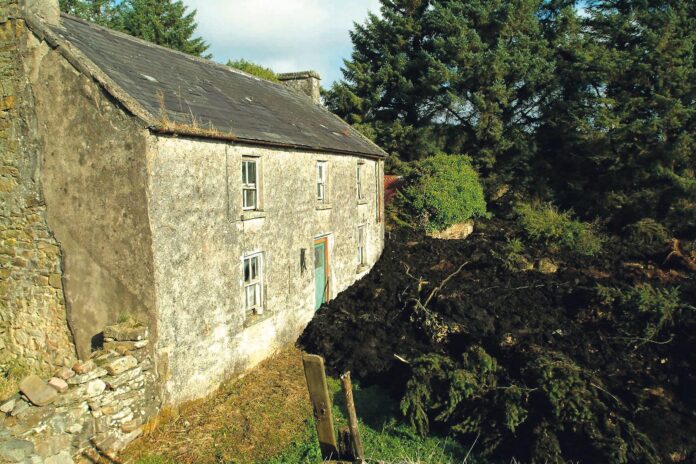THE early decommissioning of an ESB wind farm in South Galway could result in an overall taxpayer bill of up to €70 million, a local lobby group has claimed.
Following a lump sum fine of €5 million and a daily fine of €15,000 plus legal costs imposed by the European Court of Justice ruling in November 2019, the Derrybrien Wind Farm has now incurred a bill of €17,845,7779 for the state.
The penalties were levied after it found Ireland had failed to comply with a previous court ruling in relation to the wind farm where a landslide occurred during construction in 2003.
David Murray from the South Galway Flood Relief Committee estimates when fines, early decommissioning accounting for a €10 million loss annually over the life time of the wind farm, consultants fees and resolution of turbary right are factored in, the final bill and loss of earnings could be in the region of €70 million.
The ESB, through its wholly owned subsidiary Gort Windfarms Ltd, has confirmed it will decommission the Derrybrien Wind Farm in South Galway.
This follows on from the recent decision of An Bord Pleanála not to grant substitute consent following an application by Gort Windfarms Limited in response to a notice served by Galway County Council.
“ESB consequently paused operation of Derrybrien. Following careful consideration ESB has now decided to decommission the wind farm.
“ESB will now prepare for the decommissioning of the 70 wind turbines in accordance with planning laws and regulations,” said an ESB spokesman.
The capacity of the wind farm was 59.5MW. Windfarms have a typical lifespan for 20 years but that can be extended by another few years. In its substitute consent application, the ESB indicated a time frame of 2040 for decommissioning, which means the company will incur significant loss or earning through early decommissioning.
In its ruling, An Bord Pleanála stated it is not satisfied that exceptional circumstances exist that would justify the grant of substitute consent, specifically due to the significant effects on the environment, which occurred as a result of the 2003 peat slide event during the early stages of the construction phase of the development and that the works undertaken in the early stages of the construction phase had or contributed to the unacceptable direct and indirect residual effects on the environment.
While recommencement of construction was undertaken and with remedial works associated with the peat slide event incorporated into the development, the board stated this does not fully mitigate the significant environmental effects on the environment of the peat slide event.
The application to the board relates to a 70-turbine wind farm, substations, overhead grid connection, associated infrastructure, tree felling and site works, including emergency and remedial works undertaken following the occurrence of a peat slide in October 2003.
A peat slide event occurred in October 2003 during excavation work in the vicinity of T68 on the south side of the site.
According to the board, approximately 450,000 tonnes of peat were disturbed over an area of about 25 hectares and it resulted in the mass movement of c.250,000 tonnes of material downslope in a south east arc on to lands located between the wind farm site and Flaggy Bridge along the R335 via Black Road.
“The event was exacerbated by heavy rainfall in late October 2003, which in turn extended the spatial extent of the slippage along the Owendululleagh River, with fine peat sediments reaching Kinvarra Bay to the NW via Lough Cutra and the Gort/Beagh river systems.
The slippage resulted in the deposition of peat along the banks and environs of the Owendululleagh River and its tributaries, fish kills, smothering of aquatic species and diminution of water quality.
“A series of emergency stabilisation and containment works were undertaken in the immediate aftermath of the slippage including the construction of 8 x barrages and peat repositories which were used to contain and store the mobile material with four barrages remaining in place.
“When construction works resumed in 2004 following extensive geotechnical and peat stability surveys, it was decided to omit T16 and some access tracks as a precautionary measure.”
Mr Murray said the decommissioning of the wind farm has sent shock waves across the “green planning” sector and has left a lot of people outraged at the waste and their growing ESB bills.
The South Galway Flood relief committee is asking for those accountable to be held responsible for this “unmitigated disaster”.
“Since the first diggers tore into the mountain high-ground in 2003, it became an unauthorized development. When the subsequent landslide happened in October that year, it should have been stopped. They shouldn’t have dug tens of kilometres of new drains some two to three metres wide and two to three metres deep, again unauthorised.
“The ESB refused, point-blank, to engage in any progressive way with local community concerns from Derrybrien Action group and the South Galway Flood Relief Committee.
“The only option that was left to the community was to go to Europe to get support on the situation.
“If the ESB had engaged and addressed concerns, we wouldn’t be where we are today.
“The South Galway communities have paid the price (and continue to pay the price) of the impact on the wind farm. In July, last year the ESB put up notices effectively halting local turf cutting on the mountain due to peat instability, another slap in the face, without any notice/consultation.
“The lowering of water tables and extensive draining continues to increase the flood risk for South Galway. It’s not just the communities that has paid the price, the environment has also paid a heavy price with the landslide destroying water life throughout the catchment and increasing the silting in the underground network.”
The ESB declined to comment on the South Galway Flood Relief Committee’s claims.
East Clare correspondent, Dan Danaher is a journalism graduate of Rathmines and UL. He has won numerous awards for special investigations on health, justice, environment, and reports on news, agriculture, disability, mental health and community.


